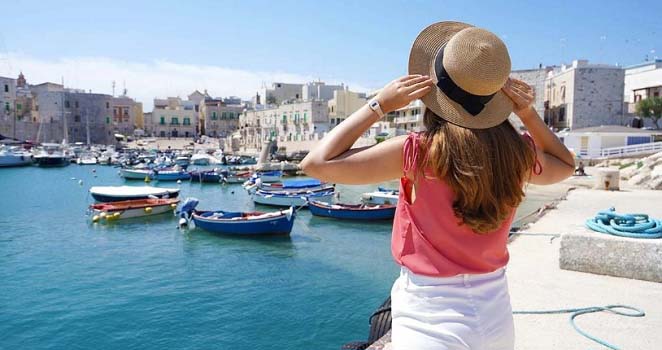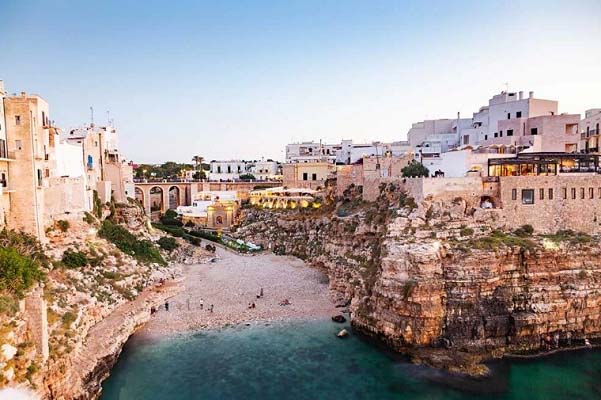Italy: Welcome to the south region of Puglia

Rome: The home of trulli, countless stunning beaches, and picturesque limestone towns
Italy is always a good option. Ancient towns in stone and marble, stretches of evergreen olive trees, and dives into its balmy waters or down the slopes of the Dolomites, some would agree this southern European country is ideal all year round, including last-minute deals.
Despite being a skinny strip of land, it’s diverse from top to bottom and no two regions are ever the same. For this reason we zoom in on just one of them and introduce the beauty of Puglia (or Apulia, as it’s known in English).
Apulia sits at the southeastern tip of the peninsula, also known as the heel of Italy’s boot. The region is closely linked to water, having the longest stretch of coastline of them all, and it reflects in the locals’ daily activities and diet with fresh seafood playing an important role in it.

With over 800 kilometers of coastline, it’s not hard to find beautiful beaches in Apulia. It can get a little crowded but you’re likely to find that one spot just to yourself with the choice of the Adriatic Sea on one side and the Ionian Sea on the other. Despite its popularity among tourists, it’s managed to retain a feeling of somewhat being undiscovered, and more relaxed than many other places in Italy.
Locorotondo organizes an annual competition to determine the best decorated balcony
Locorotondo organizes an annual competition to determine the best-decorated balcony — Shutterstock
Summers in Puglia come with scents of pines, geraniums, wildflowers, and a gazillion others that all get carried across the land to mix into a heady mixture. The town of Locorotondo organizes an annual competition Balconi Fioriti in which participants decorate their balconies with flowers (geraniums are among the favorites) and win prizes for the best-looking floral display.
If you’re traveling to Apulia by plane, chances are you’ll touch down at Bari or the more south-bound Brindisi. The two port cities are a little underrated but take some time to explore them if you’re in the area anyway and you might be pleasantly surprised what they have to offer.
Puglia’s capital, Bari, is among the busiest passenger ports in Europe with connections to different corners of the Mediterranean. On your explorations there you’ll probably not want to miss the medieval Old Town, or Bari Vecchia, condensed on a small tip of land overlooking the sea. It’s made of narrow alleyways where one can have fun getting lost on a lazy afternoon while exploring ornately decorated shrines the area is famous for.
Step out of the maze and onto the town’s promenade, for Bari is after all a coastal town. It will take you along the harbor with traditional blue fishing boats and landmarks like the former theater Teatro Margherita or a defense structure Sant’Antonio Fortino dating back to the 11th century.
Brindisi, Bari’s southern neighbor and about a third of its size, lies towards the tip of the heel. It may be smaller but no less inviting. Its perhaps most prominent structure is the castle Castello Alfonsino di Brindisi sitting right at the waterfront and offering stunning views of the harbor and the sea. Being a port town, an abundance of fresh seafood is to be expected and the Italians are known for their strong coffee, sweets, and ice cream and Brindisi is no exception.
If you decide to stay in Bari or Brindisi for a couple of hours, a long weekend, or perhaps you never want to leave, both towns are a great base for exploring the rest of the Puglia region.
As we’ve already mentioned, Puglia’s coastline has some stunning beaches. The small coastal town of Polignano a Mare is among the most photogenic Italian seaside towns. It sits on a high cliff with access to the sea and according to a legend, it was once part of Greece but broke away and became part of Italy.
If you want to relax while looking for something more unusual, head to Grotta della Poesia (Poetry cave), a natural swimming pool set in a karst cliff. There’s a small fee to enter but perhaps well worth spending an afternoon jumping 15 ft (5 m) into a giant sinkhole filled with azure blue waters.
The coastline of the Salento peninsula is dotted with beaches: sandy beaches, pebble beaches, city beaches, beaches in natural parks, beaches with dunes several meters high, beaches with water so shallow it takes minutes of walking before you can take a proper swim… you name a type of beach and you’ll likely find it here.
The historic town of Lecce is the near geographical center and capital of Salento. It’s dubbed The Florence of the South for its baroque architecture, stunning monuments and frescos. Lecce is world-known for the Lecce stone, a soft and workable limestone found only in southern Italy, close to the town itself.
Trullo is a type of traditional dwelling in the Puglia
Trullo is a type of traditional dwelling in the Puglia — Shutterstock
Leaving the lavish sights of Lecce, the region’s countryside offers unique gems of its own.
Masserias are traditional white-washed farmhouses that offer different levels of accommodation. The houses are found throughout the region and offer housing from basic to luxury services while providing an insight into the local lifestyle and traditions like sampling regional produce and learning to cook regional cuisine.
Trullo is another type of traditional housing in Puglia. It’s a limestone hut with a pointy roof, traditionally in the shape of a dome or a pyramid and painted with a symbol that usually has an astrological or religious meaning. These dwellings go back several centuries and although they are scattered throughout the entire region, most of them — and the best-preserved ones — can be spotted in Unesco’s Alberobello.
With temperatures in the winter hovering around 10C and almost no snowfall, Puglia might be a great year-round option for a quick European holiday. Kiwi.com offers flights, including low-cost flights, at great prices even if you decide for a last-minute getaway.





